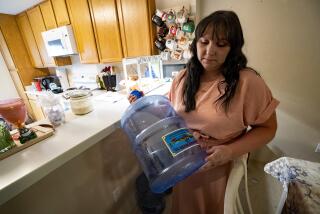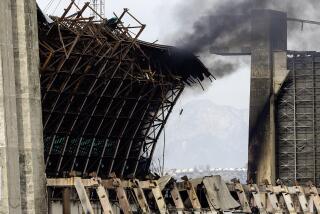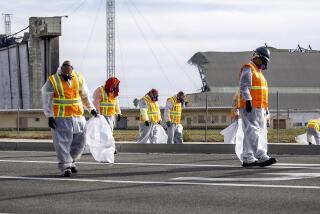Grievance Filed Over Asbestos in Navy Housing
A council of trade unions at the Long Beach Naval Shipyard has initiated a class-action grievance, alleging that about 20 shipyard workers who repair and maintain nearly 2,000 Navy dwellings in the Long Beach-San Pedro area and the residents of those dwellings are routinely exposed to asbestos, a known cause of cancer and other respiratory illnesses.
The Federal Employees Metal Trades Council, which represents about half of the shipyard’s 6,000 workers, argued the grievance at a hearing last Thursday because it was not satisfied with the Navy’s response to a Sept. 27 complaint about asbestos insulation in Navy dwellings, said the council’s local president, Frank Rodriguez.
The next step in a grievance procedure, the filing of a formal written complaint, will be taken if the shipyard does not determine whether maintenance workers and Navy families are safe and improve maintenance workers’ training, he said.
Seriousness Undetermined
Environmental health specialists nationwide have warned that the use of asbestos to insulate home furnaces and heating ducts could create a health hazard as aging asbestos deteriorates and is inhaled. But the level of the risk remains unclear, because very little testing has been done to determine the amount of asbestos that heating systems may release.
Rodriguez said that neither union officials nor the dwellings’ occupants knew asbestos had been used to wrap heating ducts in most local Navy dwellings until a worker complained of asbestos exposure in September and insulation samples from four houses were tested by the shipyard.
The maintenance workers had not protected themselves against inhaling asbestos, which can flake into the air when it becomes old and brittle or is handled, Rodriguez said.
“It’s almost like if nobody knows or nobody cares, then nothing will move,” said Rodriguez Thursday. “We haven’t seen the employees being trained. We haven’t seen them being issued safety equipment. We haven’t seen nothing.”
By Monday, however, when The Times questioned top officials at the Naval Station and the shipyard about asbestos, the two facilities had begun joint testing to determine if the level of asbestos in the air in local Navy housing is a health hazard.
Testing Under Way
Testing of 20 to 40 of the area’s 1,990 Navy dwellings should be completed by the end of this week, said Cmdr. Lindsey Kalal, executive officer of the Naval Station.
An initial sampling of three dwellings with asbestos insulation Monday and Tuesday found no airborne asbestos in one; in the other two, the levels of airborne asbestos were well below the Navy’s standard for sleeping quarters and medical facilities and at least 40 times less than the federal standard for industrial work places, he said.
“Everything our industrial hygienists have looked at so far has given us no reason for alarm,” said Kalal. “We’re quite satisfied that there is no hazard to the occupants.
“My primary concern is that . . . we don’t create undue alarm on this,” he added.
Kalal said he has been told by Navy housing officials in San Francisco that at least some of the Long Beach housing was tested for airborne asbestos in 1978 and 1979. But records of those tests apparently have been destroyed, he said. He said that 66% of the area’s Navy dwellings have asbestos insulation in their heating systems.
Capt. Kevin M. Healy, commander of the Naval Station, said that he was very concerned about any potential asbestos hazard, but “this is a labor action and should be viewed with a somewhat jaundiced eye until it is confirmed that we have a problem.”
Learned of Complaints
Gil Bond, director of industrial relations at the shipyard, said Tuesday that neither he nor the shipyard commander, Capt. George E. Fink, had been aware of the union complaint until last Friday. Testing for airborne asbestos was begun over the weekend, he said.
Bond said that union officials might be right in alleging that maintenance men for Navy housing, several of whom are temporary employees, have had little or no training on how to recognize and work with asbestos.
“I’m still trying to find out what briefings they had or should have had,” he said. “I can tell you right now that I have a lot of people looking at the problem and trying to find out where (the system) broke down, if it broke down.”
Bond said he did not know if the maintenance workers had been specifically told that asbestos was used to insulate Navy dwellings and that protective clothing should be worn when working on furnaces.
Union officials also appeared to be right in alleging that a November, 1984, complaint from a Navy housing worker had been dropped by his supervisors even though a lab test confirmed the man had been working near asbestos, Bond said. That occurred because the worker complained to his foreman, not to the shipyard’s safety and health office, he said.
“Unfortunately, (the worker) handled that informally so it wasn’t brought to our safety officer’s attention last November,” Bond said. “My perception so far is that it went into the bowels of the organization and never rose to the attention level necessary (for action).”
Substance Strictly Regulated
Handling of asbestos is strictly regulated by both federal and state law and Navy guidelines, with protective clothing mandated when asbestos materials are installed or removed, Bond and spokesmen for state and federal Occupational Safety and Health Administration offices said.
Theoretically, a single asbestos fiber can cause a deadly cancer, although the chances of that are extremely slight, some asbestos researchers have maintained.
Scientists generally say that the probability of getting an asbestos-related disease increases in proportion to length and level of exposure.
For example, the risk of asbestos diseases is extremely high among industrial workers exposed to asbestos almost daily for many years.
Lung-Scarring Disease
A 1978 study of workers at the Long Beach Naval Shipyard revealed that 31% of those at the shipyard for at least 17 years during and after World War II suffered from asbestosis, an irreversible lung-scarring disease that is often fatal.
(About 24,000 asbestos-injury lawsuits, including about 4,000 from the Long Beach Naval Shipyard, are now pending against five of the largest asbestos manufacturing companies. Hundreds of millions of dollars in claims by past and present shipyard workers are also pending against the Navy.)
Although industrial asbestos-level standards have existed for many years and the Navy has its own standard for housing and medical areas, there is no national or state standard for a “safe” level of asbestos for homes, offices, schools or other public buildings.
“We don’t know what a safe level is,” Albert Limberg, deputy director of the Western region of the federal Consumer Product Safety Commission, said last week. “In layman’s terms, if you’re exposed to asbestos you run a serious risk of getting sick.”
But Steven Hayward, acting director of the indoor air quality program at the state Health Department’s Air and Industrial Hygienic Lab, said the danger of asbestos exposure is analogous to cigarette smoking. “Smoking one cigarette in a lifetime could cause lung cancer,” he said. But the chances of it are infinitesimal, he added.
More to Read
Sign up for Essential California
The most important California stories and recommendations in your inbox every morning.
You may occasionally receive promotional content from the Los Angeles Times.










